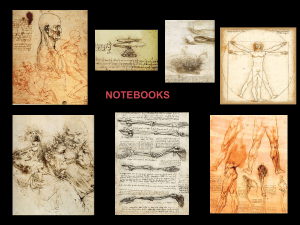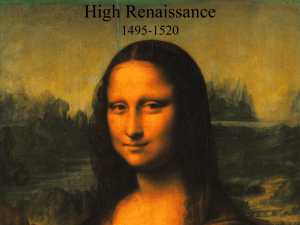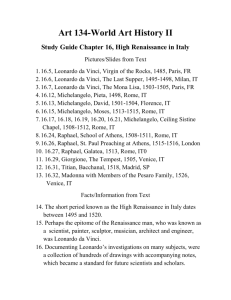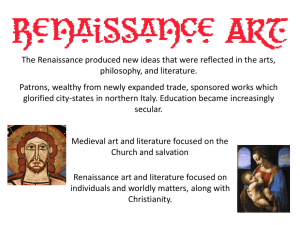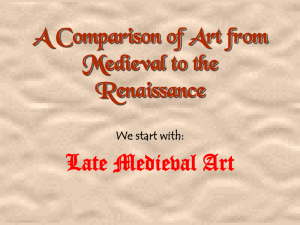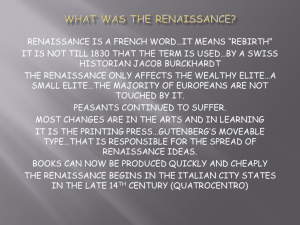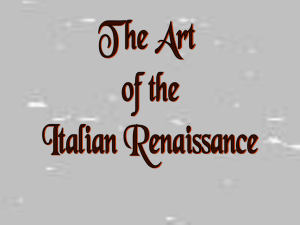Artists
advertisement
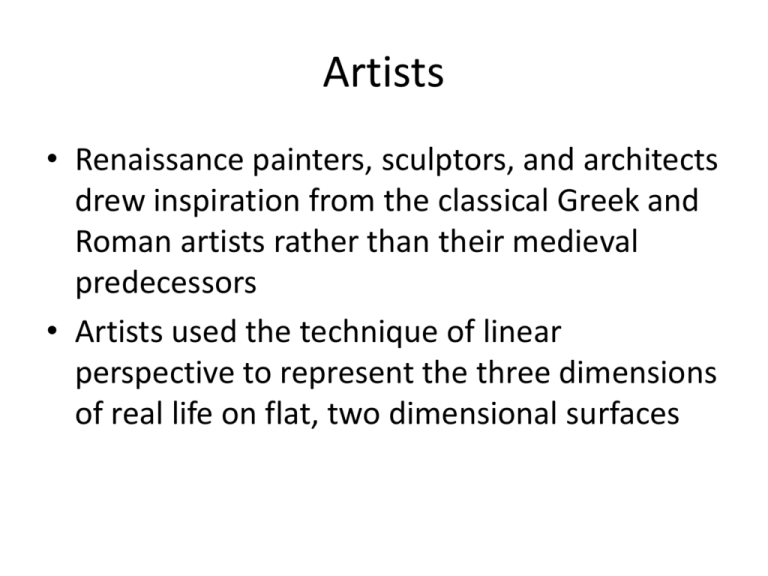
Artists • Renaissance painters, sculptors, and architects drew inspiration from the classical Greek and Roman artists rather than their medieval predecessors • Artists used the technique of linear perspective to represent the three dimensions of real life on flat, two dimensional surfaces Difference in Painting Medieval Renaissance (The Virgin and Child with Saint Anne by da Vinci, 1510) Difference in Painting Medieval Renaissance (Pope Julius II by Raphael) I. Self-Portrait -- da Vinci, 1512 Artist Sculptor Architect Scientist Engineer Inventor 1452 - 1519 Leonardo, the Artist: From hisNotebooks of over 5000 pages (1508-1519) Leonardo da Vinci (1452-1519) • A great artist, but more than any other person of his age, personified the idea of the “Renaissance man” – Someone of broad interests who is accomplished in both the arts and sciences Mona Lisa uses light and shadow and perspective to make the figures fully human, enigmatic, and mysterious The Last Supper captures the emotions of each of Jesus’ disciples at the exact moment of their learning one will betray Him The Last Supper - da Vinci, 1498 & Geometry vertical The Last Supper - da Vinci, 1498 horizontal Perspective! Leonardo da Vinci da Vinci’s study of the proportions of the human body da Vinci’s plans for a helicopter Leonardo, the Scientist (Biology): Pages from his Notebook An example of the humanist desire to unlock the secrets of nature. Leonardo, the Scientist (Anatomy): Pages from his Notebook Giotto di Bondone (1266-1337) • Overcame the obstacle of flat forms by skillfully contrasting light and shadow to create an illusion of depth that made human figures look solid and round “The Mourning of Christ,” painted c.1305 Masaccio (Tomassco Guidi) (1401-1428) • Used atmospheric perspective to show objects receding into a background and to make figures appear round and truly three dimensional Trinity 1425-28 Fresco El Greco (Domenikos Theotokopoulos) (1541-1614) • Used severe colors and elongated features to express Spanish religious zeal in powerful and emotional paintings The Burial of Count Orgaz conveys the Catholic spirit of communion among God, saints, and humans Sculptors • Sculptors depicted their subjects in natural poses that reflected the actual workings of human muscles rather than the awkward and rigid poses often found in earlier sculptures II. Michelangelo Buonorrati 1475 – 1564 He represented the body in three dimensions of sculpture. Michelangelo Buonarotti (1475-1564) • Considered himself a sculptor first and painted with a sculptor’s eye • Made the muscular masculine figure his ideal beauty Michelangelo’s David and Moses show dramatic and emotional postures and expressions David Michelangelo Buonarotti 1504 Marble The Popes as Patrons of the Arts The Pieta Michelangelo Buonarroti 1499 marble The Sistine Chapel Michelangelo Buonarroti 1508 - 1512 Sistine Chapel Michelangelo’s frescos covering the ceiling of the Sistine Chapel in the Vatican are perhaps the single greatest achievement in Renaissance art The Sistine Chapel Details The Creation of the Heavens III. Donatello (Donato di Niccoli di Betto) (1386-1466) • Traveled to Rome to study the classics of antiquity • Employed models and created studies of anatomy and the human body Donatello’s David was the first nude statue of the Renaissance and is known for its grace, proportionality, and balance IV. Raffaello Sanzio (1483-1520) Self-Portrait, 1506 Portrait of the Artist with a Friend, 1518 Raphael Sanzio (1483-1520) • Excelled in composition and use of soft colors Raphael is famous for his warm, pious, and graceful Madonnas such as The Small Cowper Madonna, c. 1505 St. George Fighting the Dragon, 1505 Raphael’s Madonnas (1) Sistine Madonna Cowpepper Madonna The School at Athens by Raphael The School of Athens – Raphael, 1510 -11 One point perspective. All of the important Greek philosophers and thinkers are included all of the great personalities of the Seven Liberal Arts! A great variety of poses. Located in the papal apartments library. Raphael worked on this commission simultaneously as Michelangelo was doing the Sistine Chapel. No Christian themes here. The School of Athens – Raphael, details Plato: looks to the heavens [or the IDEAL realm]. Aristotle: looks to this earth [the here and now]. The School at Athens, with lines to show perspective The School of Athens – Raphael, 1510 -11 Da Vinci Raphael Michelangelo Portrait of Pope Julius II by Raphael, 1511-1512 More concerned with politics than with theology. The “Warrior Pope.” Great patron of Renaissance artists, especially Raphael & Michelangelo. Died in 1513 Birth of Venus – Botticelli, 1485 An attempt to depict perfect beauty.


